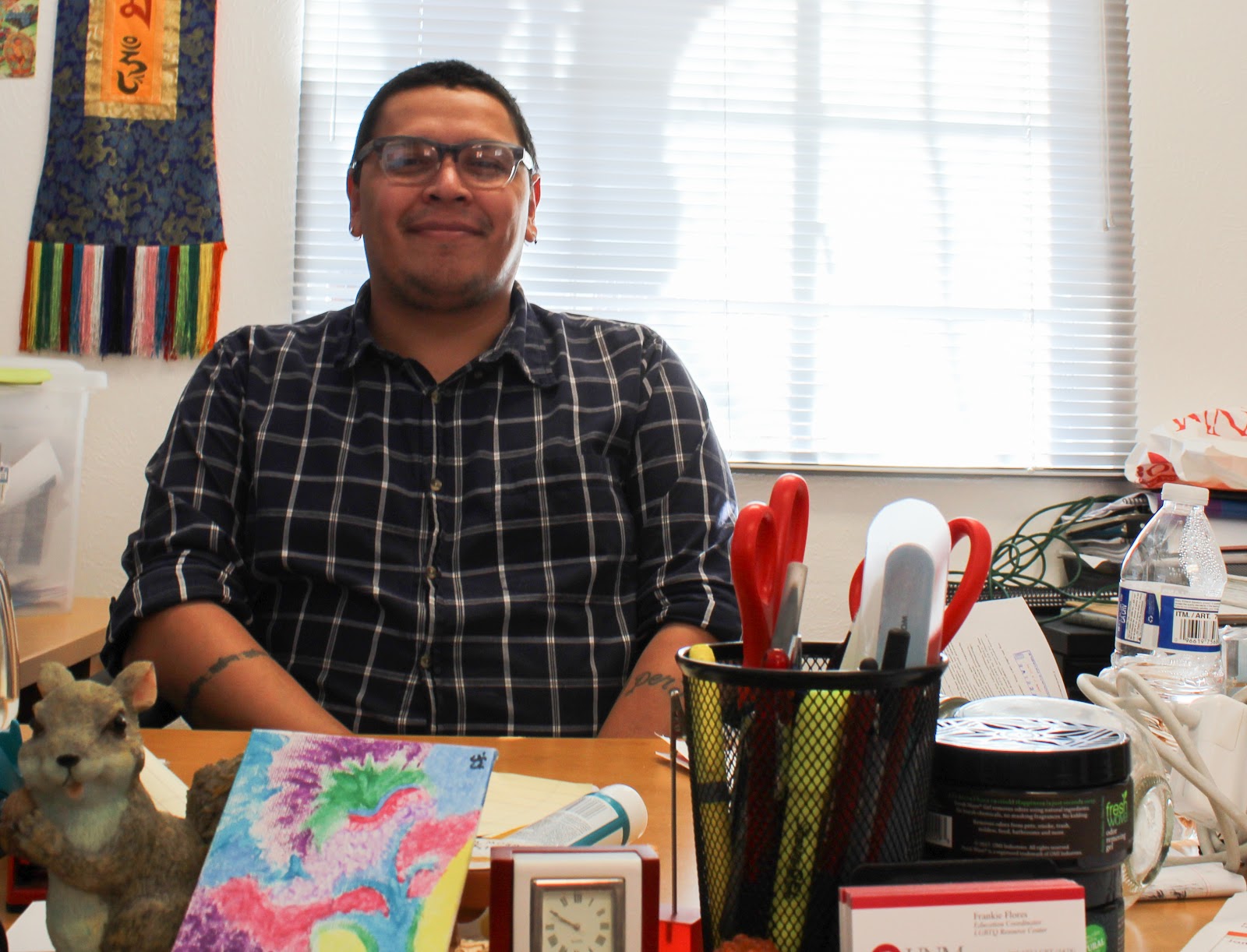By Marco Woods / NM News Port /
Major depressive episodes are on a increase for youths in New Mexico, and lesbian, gay, bisexual and transgender youths are at greater risk, according to local experts.
Frankie Flores, educational coordinator for the LGBTQ Resource Center at UNM, said he thinks there is a rising hopelessness showing up.
“I think there’s a lot of youth who don’t feel like they have anything to look forward to,” he said.

Poverty and lack of resources in the state are all contributors to the problem, but the problems are often magnified among gay and lesbian youth who may be battling social stigma or bullying, he said.
A report was released last December from Substance Abuse and Mental Health Service Administration, or SAMHSA, that shows updated information regarding mental health and substance abuse for 2015-2016 in the United States. SAMHSA defines a major depressive episode as period of at least two weeks where an individual has a depressed mood or loss of pleasure from daily activities and had experienced depression symptoms. New Mexico had 12.61 percent of youths who experienced a major depressive episode, an increase from previous years.
![]()
Depression is an issue that affects all of New Mexico’s youth, but hits the LGBTQ community harder than most. NM-IBIS showed that the LGBTQ’s youth population had a much higher percentage of individuals who persistently felt sad or hopeless and had more members who seriously consider suicide, when compare to straight youths. LGB youth were also much more likely to attempt suicide and be injured in the process.
The CDC’s YRBSS online tool shows that feelings of sadness and hopelessness between 2013 and 2015 was rising for gay and lesbian students, while staying relatively the same for bisexual youth. While gay and lesbian youth had an increased percentage of members who seriously considered suicide in the past, the percentage of youth who attempt suicide are down in 2015 when compare to 2013. However, bisexual youth saw a percentage rise in individuals who seriously considered suicide and those who attempted suicide.
![]()
The U.S. Transgender Survey in 2015, which is not age specific, had 45 percent of respondents for New Mexico that reported they experienced serious psychological distress within the last month of completing the survey.
There is nothing inherent that would make LGBTQ youth more at risk for depression, said Ruben Zurita, who is a licensed clinical counselor at UNM’s Student Health and Counselling (SHAC) and previously worked with high schoolers in Illinois. Zurita acts as a liaison between SHAC and the LGBTQ Resource Center at UNM.
![]()
“Being a gay [or being lesbian or bisexual or transgender] adolescent in it of itself does not cause you to have depression,” he said.
But, being a part of a minority group, like LGBTQ, can lead to increased risks for depression due to additional stressors, such as bullying or rejection from family members, he said.
Issues with Acceptance and Bullying
For students, especially high schoolers, there is a desire to fit in, said Talia Montano, a shift manager at the Agora Crisis Center.
![]()
“Feeling like you can’t do that definitely puts constraints on how you’re going to interact with people and how people are going to interact with you,” she said.
Acceptance and feeling like you are worth something is important, Montano said. LGBTQ members may feel isolated or worthless and may feel like they can’t be who they are because they have no one they feel comfortable talking to about this, she said.
Fear of rejection from both family members and social groups can cause feelings of isolation and loneliness, said Flores.
![]()
Fear of losing friends and damaging family relationships can lead to LGBTQ youth keeping it a secret, he said.
“So often there are times you’ll hear LGBTQ youth who don’t know anybody else who’s like them,” he said.
Bullying is an issue for all adolescents, but can be worse for those who have a notable difference, such as the LGBTQ community, Zurita said.
The YRBSS shows that a larger percentage of LGB high schoolers were bullied on school property, compared to straight students. The percentage of LGB students who experience electronic bullying was more than twice as much as straight students.
![]()
Bullying can tear people down and cause people to feel like they’re not worthy of anything, Flores said.
This can cause individuals not to care, he said.
Difficulties with Family
Desire for acceptance expands to family members as well. If family members have certain religious or political beliefs that view non-heterosexual activity negatively, then this can lead to a disconnect and conflict between LGBTQ youth and family members, Zurita said.
“Parents can both love their children, but at the same time hold very negative opinions about their children, regarding certain perceived behaviors,” he said.
Hearing family members talking negatively about LGBTQ individuals can lead to one feeling shameful about themselves, Flores said.
![]()
A 2015 poll from the Pew Research center shows that about 57 percent of parents would not be upset to find out there child is gay or a lesbian, while about 39 percent would be somewhat or very upset.
Parents may have a set belief structure that they think their children should follow, Zurita said.
Going against that structure can cause pressure for LGBTQ youth.
Individuals may not feel safe coming out, Flores said.
The idea that it will get better after you come out is not always true, especially for those of color who face additional barriers, he said.
“I believe that if you’re in a space where you can come out, then you absolutely should,” he said. “But if it’s not safe for you, you don’t have to.”
Fear may expand beyond just social rejection.
The body of a transgender woman, who was killed in a double homicide, was found last month. Incidents like these make the community fearful for their safety and may contribute to them not coming out, Flores said.
Having a supportive family or other supporting factors can help prevent depression, Zurita said.
LGBTQ groups in high school can help in this regard, while conflict and tension can do the opposite, he said.
There is more acceptance for sexual orientation and gender identity, though there are still a lot of issues present, Zurita said.

“I think that Millenials are going to save us,” said Dan Matthews, director of UNM’s psychology clinic. “I think that it’s easy to focus on what’s bad, but I think that it’s important to look at what’s getting better.”
When Matthews was younger, being a part of the LGBTQ community was considered immoral or even a mental disorder.
People were forced into the closet out of fear. Although over time, acceptance has increased, he said.
“This has to be a healthy direction, [but] it doesn’t mean we’ve reached health,” he said.
Barriers to Receiving Treatment
In addition to stigma surrounding LGBTQ, youth face barriers when it comes to receiving treatment. According to the 2018 State of Mental Health report from Mental Health America, or MHA, 69.2 percent of youths in New Mexico who experienced a major depressive episode did not receive treatment.
Access to health care and poverty in the state may play into the role of high rates of depression in New Mexico, Montano said.
“We tend to be a more rural location, meaning access to resources could be within 10 plus miles of a adolescent who doesn’t have a car,” she said.
In certain areas, youths may have a lack of resources available to them, meaning that they can’t access a mental health professional, Montano said.
Outside of Albuquerque, there isn’t much help available, she said.
“We do not have a whole lot of money to fund things,” she said. “We are so spread out across the state that for some people, say [in] Grants or Gallup, it’s not as easy to access these resources as it is for someone in Albuquerque.”
Not being able to afford the cost of mental health resources is an issue that adds to the problem, Montano said.
Matthews agreed that payment is one of the biggest barriers to treatment for depression.
“In my belief, everyone should have health insurance, it should be a right,” he said. “This is a moral position, not a science based position.”
In addition to stigma in the LGBTQ community, there may also be stigma in having depression which may also be a barrier for treatment, Matthews said.
People don’t look down on others like they used to for being depressed, but there is self-stigma and worries on how one may be perceived if people knew they were depressed, he said.
Part of the issue is that people don’t like to be labeled — being seen as your illness, Montano said.
“The interesting thing is that we don’t say that people are cancer, you don’t say people are certain sickness and yet we say that people are depressed,” she said.
The solution to stigma surrounding depression is education as well as giving people the tools for the next steps in recovery, Montano said.
Resources
When it comes to helping those with depression showing that you are there to help is important, Flores said.
“Are you stepping up for us?” he said. “If you’re seeing someone getting bullied, are you saying something?”
It is also important to ask what they need because sometimes tasks like eating or showering can become difficult when depressed, Flores said.
For those struggling with or know someone who is struggling with depression or suicide, there are resource available. There are also groups within New Mexico that focus on providing support to the LGBTQ community. Resources in New Mexico include:
- The Agora Crisis Center provides over-the-phone support available to anyone at: 505-277-3013
- New Mexico Crisis and Access line, which provides suicide prevent support statewide, at: 855-662-7474
- LGBTQ Resource Center provide support for LGBTQ individuals.
- Transgender Resource Center of New Mexico, focuses on providing support to transgender communities in New Mexico.
For more follow Marco Woods on Twitter